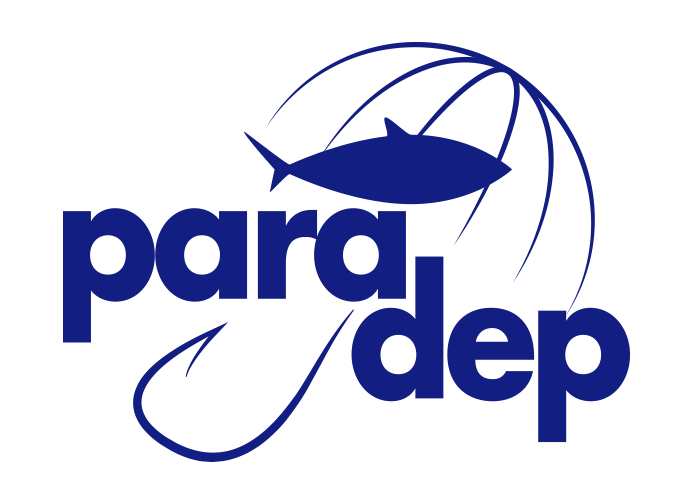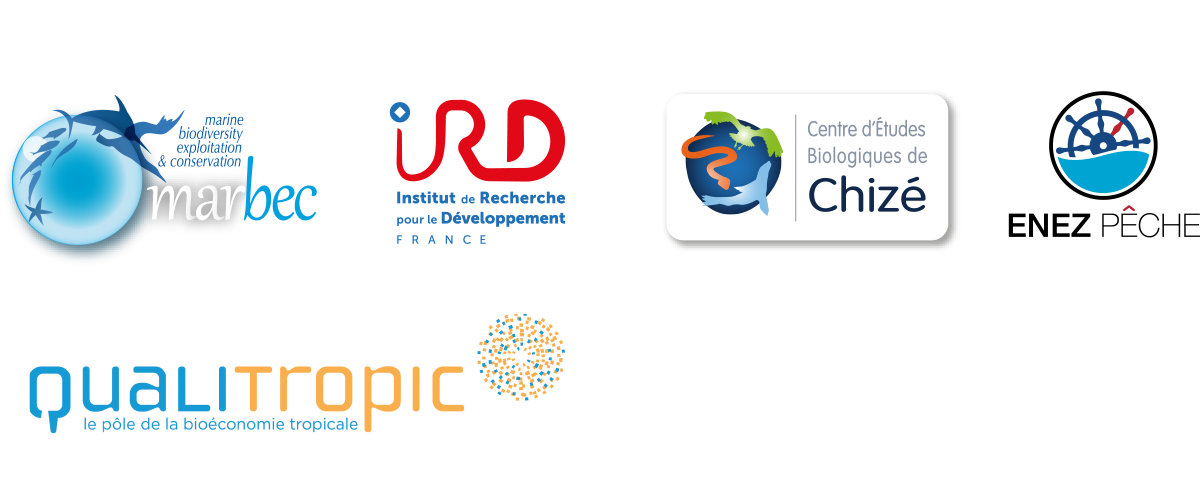Depredation in marine ecosystems is defined as the damage or removal of fish or bait from fishing gear by predators, and more specifically, by toothed whales. It leads to several negative consequences impacting conservation (bycatch of marine mammals, modification of their hunting behaviour), stock assessment (depredated fish not included in fish stock assessment) and fisheries economy (loss of fish). The long term objective of PARADEP is to reduce toothed whale depredation impacting pelagic longline fisheries targeting tuna and swordfish, by developing a physical depredation mitigation device.
The PARADEP project is a unique collaboration between scientists and fishermen. It involves two French labs, whose research focuses on fisheries science (IRD MARBEC) and marine predator ecology (CEBC CNRS), and a pelagic longline fishing company (ENEZ DU, based in Reunion Island, Indian Ocean). It is funded by the European Funds for Maritime Affairs and Fisheries (FEAMP). The project will run for 30 months (July 2018-December 2020). The device conception will take place in Niort (France), and the device trials will take place in the Etang de Thau (Sète, France) and in Reunion Island (Indian Ocean).
The general objective of PARADEP comes in several components including project management (WP1), communication and dissemination (WP2), scientific research (WP3 and WP4) and economic study (WP5).
The communication objective of PARADEP (WP2) is to share the knowledge resulting from the chosen approach to the public, political managers, stakeholders, scientists and fishermen. This will be done by the use of several communication supports, including the construction of a website dedicated to the project (https://paradep.com), the organisation and participation to various workshops, conferences and meetings and fairs, and the publication of scientific papers.
The first scientific objective of PARADEP (WP3: Device conception) includes two sub-objectives. The first one (WP3.1) is to develop a physical depredation mitigation device for pelagic longline fisheries. This innovative device will have three protective skills: a physical protection (physical barrier between the fish and the predator), a visual protection (hiding of the fish) and a passive acoustic protection (modification of the acoustic signature of the fish). This technological innovation will use a passive and non-invasive system by using bio-based materials. It will be deployed around the fish, as soon as it is captured. This device will be developed in collaboration with the SATIM Company, based in Niort (France) and specialized in the design of special machines. The second sub-objective (WP3.2) is to propose further insights into the design of a second device (or into ways of improving the first one). This will be done in collaboration with the LEME laboratory (University of Paris Nanterre, France), specialized in Energetics, Mechanics and Electromechanism.
The second scientific objective of PARADEP (WP4: Device trials and acoustic surveys) includes three sub-objectives. The first one (WP4.1) is to assess the underwater behaviour of the prototype in a shallow basin (Etang de Thau, Sète, France). Once the prototype behaviour is validated, large scale trials will be undertaken in Reunion Island on board pelagic longliners during commercial fishing trips (WP4.2). The third objective is to acoustically monitor the depredation process. Several hydrophones, cameras and accelerometers will be deployed on the fishing gear along with the devices. This will allow to detect toothed whale presence in the vicinity of the longline, to identify the involved species and to analyze their acoustic behaviour when they interact (or not) with the devices (WP4.3).
Along with the device conception, economic study will also be undertaken (WP5). It aims at assessing direct and indirect loss due to depredation in the Reunion Island pelagic longline fishery, based on the fish market price, and the running costs of a fishing trip (bait, fuel, salary). The market position of the device in the area of fishing equipment will also be assessed, based on its estimated price.
At the end of the project, we expect to propose an effective depredation mitigation device which will reduce toothed whale depredation impacts on pelagic longline fisheries. By reducing depredation, resource management and fishermen income will be improved.
Poster (pdf)
Depredation, defined as the damage or removal of fish from fishing gear by predators, is an issue leading to negative impacts on animals and fisheries. Toothed whale depredation in pelagic longline fisheries targeting swordfish (Xiphias gladius) and tuna (Tuna spp) involves short-finned pilot whales (Globicephala macrorhynchus) and false killer whales (Pseudorca crassidens). In the Seychelles archipelago, a database was built to assess the extent of this phenomena and to analyse how fishing practices could be involved in. Data analyzed came from fishermen logbooks and scientific cruises and covered the 2002-2006 period, representing a total of 705 fishing operations. The proportion of sets impacted by toothed whale depredation was 16% while the proportion of damaged fish reached 58% when toothed whales interacted with longlines. Toothed whale global depredation rate reached 10.7%. Logistic regression analysis and generalized additive models showed that both depredation occurrence and rate were positively related to the abundance of target fish, suggesting the co-occurrence of toothed whales in areas of high concentration of pelagic fish. Obviously, alternative fishing practices cannot be considered as an efficient way to mitigate depredation. Consequently we investigated fishing gear improvement by deploying a technology designed to physically protect the hooked fish by hiding them to predators. The efficiency of “spiders” was tested during a fishing trial of 26 longline fishing operations when 12480 hooks and 1970 devices were set. 117 fish were caught on branchlines equipped with spiders and among those devices, 87.3% were correctly triggered and 80% of capture were correctly protected. While more trials should be carried out to deeply verify the efficiency of “spider” devices, we remain convinced that the consideration of the fishing gear technology might be more actively investigated to propose innovative measures to mitigate toothed whale depredation in pelagic longlining.
Depredation is defined as the damage or removal of fish from fishing gear by predators, and is an issue leading to negative impacts on animals involved in depredation and fisheries. Depredation on pelagic longliners targeting swordfish (Xiphias gladius) and tuna (Tuna spp) involves short-finned pilot whales (Globicephala macrorhynchus), false killer whales (Pseudorca crassidens) and some pelagic sharks. In the Seychelles archipelago, a database was built to assess its extent on the pelagic longline fishery and to identify fishing practices likely to influence depredation. Data were collected from pre-existing databases, fishermen logbooks and satellite-based Vessel Monitoring System information, and covered the 2002-2006 period, representing a total of 705 fishing operations. The number of sets impacted by shark depredation was significantly greater than the number of sets involving toothed whale depredation. Nevertheless, when depredation occurred, the proportion of fish damaged by toothed whales was significantly greater. Depredation occurrence was analyzed by using logistic regression. Toothed whale depredation occurrence was positively related to the abundance of target fish and the fishing area (being more frequent in the south-west of the archipelago). Shark depredation was more frequent in the north-west of the archipelago. Depredation rate was analyzed by implanting Generalized Additive Models. Toothed whale depredation rate depended on the fishing area. Shark depredation rate was negatively related to the longline length and the latitude. Both depredation types occurred in areas of high CPUE (Catch Per Unit Effort), suggesting the co-occurrence of sharks and toothed whales in areas of high concentration of pelagic fish. Otherwise, toothed whales damaged significantly more swordfish than tuna, whereas sharks equally damaged both species. The global depredation rate reached 19.3% (10.7% were due to toothed whales and 8.6% were due to sharks). No obvious answers can be given by modifying fishing practices and other solutions have to be investigated to reduce depredation impacts.


